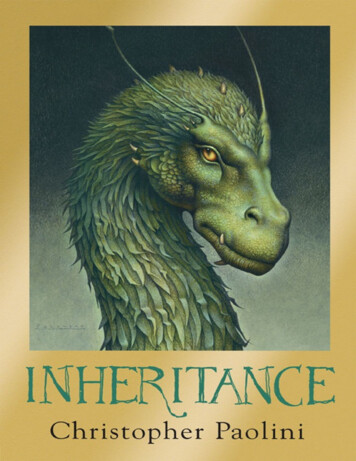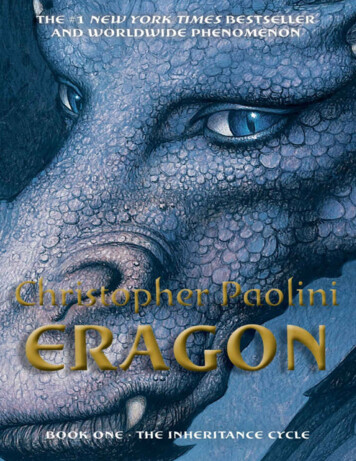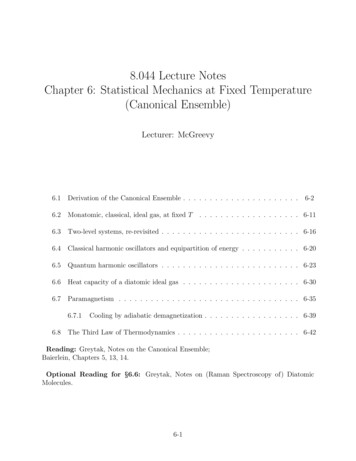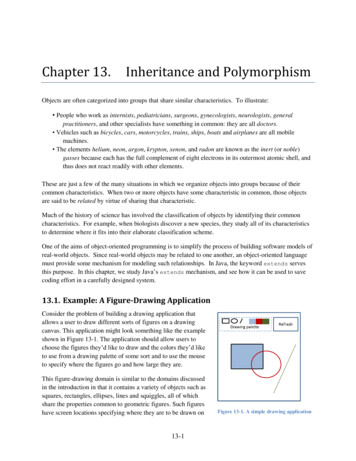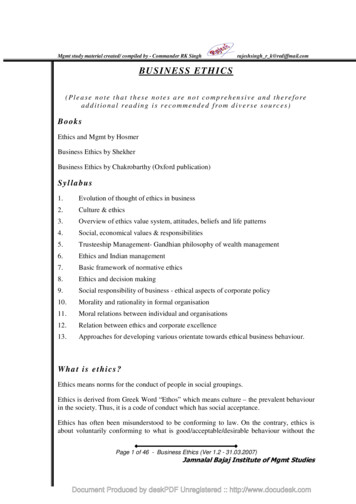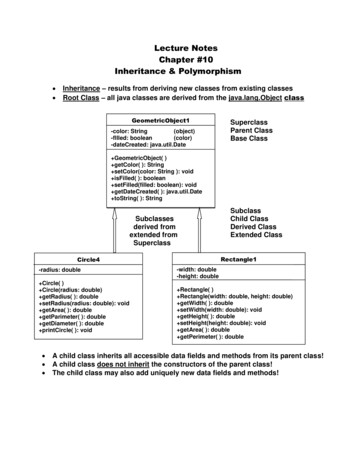
Transcription
Lecture NotesChapter #10Inheritance & PolymorphismInheritance – results from deriving new classes from existing classesRoot Class – all java classes are derived from the java.lang.Object classGeometricObject1GeometricObject -color: String(object)-fllled: boolean(color)-dateCreated: java.util.DateSuperclassParent ClassBase Class GeometricObject( ) getColor( ): String setColor(color: String ): void isFilled( ): boolean setFilled(filled: boolean): voidvoid getDateCreated( ): java.util.Date toString( ): StringSubclassesderived fromextended fromSuperclassRectangle1Circle4-radius: double Circle( ) Circle(radius: double) getRadius( ): double setRadius(radius: double): void getArea( ): double getParimeter( ): double getDiameter( ): double printCircle( ): voidSubclassChild ClassDerived ClassExtended Class-width: double-height: double Rectangle( ) Rectangle(width: double, height: double) getWidth( ): double setWidth(width: double): void getHeight( ): double setHeight(height: double): void getArea( ): double getPerimeter( ): doubleA child class inherits all accessible data fields and methods from its parent class!A child class does not inherit the constructors of the parent class!The child class may also add uniquely new data fields and methods!
1. Implementationa. GeometricObject1.javapublic class GeometricObject1{private String color “white”;private boolean filled;private java.util.Date dateCreated;public GeometricObject1( ) { dateCreated new java.util.Date( ); }public String getColor( ) { return color; }public void setColor(String color) { this.color color;}public boolean isFilled( ) { return filled; }public void setFilled(boolean filled) { this.filled filled; }public java.util.Date getDateCreated( ) { return dateCreated; }public String toString( ) { return “created on “ dateCreated “\ncolor: “ color “ and filled: “ filled; }}b. Circle4.javapublic class Circle4 extends GeometricObject1{private double radius;public Circle4( ) { }public Circle4(double radius ) { this.radius radius; }public double getRadius( ) { return radius; }public void setRadius( double radius) { this.radius radius; }public double getArea( ) { return radius * radius * Math.PI; }public double getDiameter( ) { return 2 * radius; }public double getPerimeter( ) { return 2 * radius * Math.PI; }public void printCircle( ){System.out.println(“The circle is created “ getDateCreated( ) “ and the radius is “ radius);}}
c. Rectangle1.javapublic class Retangle1 extends GeometricObject1{private double width;private double height;public Rectangle1( ) { }public Rectangle1(double width, double height ){this width width;this height height;}public double getWidth( ) { return width; }public void setWidth(double width) { this width width; }public double getHeight( ) { return height; }public void setHeigth(double height) { this height height; }public double getArea( ) { return width * height: }public double getPerimeter( ) { return 2 * (width height); }}d. TestCircleRectangle.javapublic class TestCircleRetangle{public static void main(String[ ] args){Circle4 circle new Circle4(1);System.out.println( circle.toString( ));System.out.println( circle.getRadius( ));System.out.println(circle.getArea( ) );System.out.println( circle.getDiameter( ));Rectangle1 rectangle new Rectangle1(2,4);System.out.println( rectangle.toString( ));System.out.println(rectangle.getArea( ) );System.out.println( rectangle.getPerimeter( ));}}See Liang page 334 for outputof TestCircleRectangle.java
Remark: A subclass is NOT a subset of its superclass; in fact, since the subclasshas access to more items than the superclass, an instance of thesuperclass can be thought of as a subset of an instance of thesubclass!Remark: Inheritance is used to model is-a relationships; e.g., an apple is a fruit!For a class B to extend a class A, class B should contain more detailedinformation than class A.A subclass and a superclass must have an is-a relationshipRemark: C allows inheritance from multiple classes; i.e., it supports multipleinheritance.Remark: Java does not allow inheritance from multiple classes; a Java class mayinherit directly only from one superclass, i.e., the restriction is known assingle inheritance. If the extends keyword is used to define a subclass,it allows only one parent class. Multiple inheritance in java is achievedby the use of interfaces.2. Constructor ChainingA child class inherits all accessible data fields and methods from its parentclass, BUT the child class does not inherit the constructors of the parentclass!“this” keyword – refers to the calling object – self-referential“super” keyword – refers to the parent of the calling object – used too call a superclass constructor super( ) invokes the no-arg constructor of its superclass super(argument list) invokes the superclass constructor thatmatches the argument list the call for a superclass constructor must be the first statement inthe subclass constructor invoking a superclass constructor name in a subclass causes asyntax error if a subclass does not explicitly invoke its superclass constructor,the compiler places the “super( )” statement as the first line in thesubclass constructor, i.e.,public A( ){ }public A( ){ super( ); }
keywordpublic class Faculty extends Employee{public static void main(String[ ] args){new Faculty( );}KeyConstructor CallsConstructor Returnspublic Faculty( ){System.out.println(“(4) Faculty no-arg constructor invoked”);}}class Employee extends Person{public Employee( ){this(“(2) Employee’s overloaded constructor invoked”);System.out.println(“(3) Employee’s no-arg constructor invoked”);}public Employee( String s ){System.out.println(s);}}class Person{public Person( ){System.out.println(“(1) Person’s no-arg constructor invoked”);}}Construction of theFaculty ObjectFaculty Constructor (4)Employee Constructor (3)Employee Constructor (2)Person Constructor (1)The Parent Constructor isalways invoked beforethe Child ConstructorThe object is built like alayer cake from thebottom-up
public class Apple extends Fruit{public Apple( ){ }}class Fruit{public Fruit(String name){System.out.println(Fruit constructor is invoked”);}}Best PracticesPROVIDE EVERY CLASS WITH A NO-ARG CONSTRUCTORSUCH A POLICY AIDS THE EXTENSION OF THE CLASS, I.E.,IT AVOIDS THE ERROR DELINEATED ABOVESince the Apple class does nothave any constructors, a noarg constructor is implicitlydeclared.The Apple no-arg constructorautomatically invokes the Fruitno-arg constructor; but Fruitdoes not have a no-argconstructor. But since Fruithas an explicitly declaredconstructor with a parameter,i.e.,public Fruit(String name),then the complier cannotimplicitly invoke a no-argconstructor.Hence, an Apple object cannotbe created and the programcannot be compiled!
3. Overriding Methods“super” keyword is also used to call a superclass methodsubclasses inherit methods from their superclassesa subclass may modify the definition of an inherited method for use in thatsubclass – method overridingpublic class GeometricObject1{private String color “white”;private boolean filled;private java.util.Date dateCreated;public GeometricObject1( ) { dateCreated new java.util.Date( ); }public String getColor( ) { return color; }public void setColor(String color) { this.color color;}public boolean isFilled( ) { return filled; }public void setFilled(boolean filled) { this.filled filled; }public java.util.Date getDateCreated( ) { return dateCreated; }public String toString( ){return “created on “ dateCreated “\ncolor: “ color “ and filled: “ filled;}}The Circle4 toString( ) method overridesthe GeometricObject1 toString( ) method ; itinvokes the GeometricObject1 toString( )method and then modifies it to specifyinformation specific to the circle4 object.public class Circle4 extends GeometricObject1{private double radius;public Circle4( ) { }public Circle4(double radius ) { this.radius radius; }public double getRadius( ) { return radius; }public void setRadius( double radius) { this.radius radius; }public double getArea( ) { return radius * radius * Math.PI; }public double getDiameter( ) { return 2 * radius; }public double getPerimeter( ) { return 2 * radius * Math.PI; }public void printCircle( ){System.out.println(“The circle is created “ getDateCreated( ) “ and the radius is “ radius);}public String toString( ){return super.toString( ) “\nradius is “ radius;}}
a. Rules for Overridding Inherited Methodsprivate data fields in a superclass are not accessible outside of that class,hence they cannot be used directly by a subclass; they can be accessed &/ormutated by public accessor &/or mutators defined in the superclassan instance method can be overridden only if it is accessible; private methodscannot be overriddenif a method defined in a subclass is private in its superclass, the two methodsare completely unrelateda static method can be inherited, but a static method cannot be overriddenremember that static methods are class methodsif a static method defined in a superclass is redefined in a subclass, themethod defined in the superclass is hidden; the hidden static method can beinvoked by using the syntax “SuperClassName.staticMethodName( );”b. Overriding versus Overloadingi. Overloading – same name, different signituresii. Overriding – method defined in the superclass, overridden in a subclassusing the same name, same signature, and same return type as defined inthe superclasspublic class Test{public static void main(String [ ] args){A a new A( );a.p(10);}a.p(10) invokes class A}public class Test{public static void main(String [ ] args){A a new A( );a.p(10);}}a.p(10) invokes class Bclass B{public void p(int i){ }}class B{public void p(int i){ }}method; hence prints 10class A extends B{public void p(int i){System.out.println(i);}}overridesmethod; hence prints nothingclass A extends B{public void p(double i){System.out.println(i);}}overloads
4. Object Class & MethodsEvery class in Java is descended from java.lang.ObjectIf no inheritance is declared when a class is defined, the class is a subclassof Object by defaultpublic String toString( );returns a string consisting of the objects name, the @ sign, and theobjects memory address in hexadecimal, e.g., student@B7F9A1o Override the toString( ) method to produce relevant informationconcerning the subclass objectso System.out.println(student); System.out.println(student.toString( ));public boolean equals(Object obj) { return (this obj); }default implementation tests whether two reference variables point tothe same objectInvoked by the statement object1.equals(object2);o Override the equals( ) method to test whether two distinct objectshave the same content, e.g.,public boolean equals(Object o){if (o instanceof Circle){return radius ((Circle)o).radius;}else return false;}INSTANCEOF OPERATORo instanceof Circlereturns true if o is an instance of CircleDo not use (Circle o) as the argumentwhen overriding the equals( ) method,i.e., do not use the signaturepublic boolean equals( Circle o)see page 355 #10.12Comparison Operators/Methodso “ ” operator is used to compare primitive data type valueso “ ” operator is also used to compare whether two referencevariables refer to the same object (where arrays may be consideredto be objects)o The modified “equals( )” method can be used to determine whethertwo objects have the same contentso The “equals( )” method can be modified to test the contents of all ora selected subset of the data fields in the class
5. Polymorphism, Dynamic & Genetic Programminga class defines a typea type defined by a subclass is a subtypea type defined by a superclass is a supertypea variable must be declared to be of a specific typethe type of a variable called it’s declared typea variable of a reference type can hold a null value or a reference to anobjectan object is an instance of a classa subclass is a specialization of its superclassevery instance of a subclass is an instance of its superclasso every circle is an objectan instance of a superclass is not an instance of a subclasso not every object is a circlean instance of a subclass can be passed to a parameter of its superclass,i.e., a Circle object can be passed to a GeometricObject class prarameterpolymorphism – an object of a subtype can be used whenever itssuperclass object is required; i.e., a variable of a supertype can refer to asubtype objectdynamic binding – given an inheritance chain as follows,class C4and the objectclass C3class C2class C1C1 o new C1( );if the object o were to invoke a method, i.e., o.p( ); then the JVM searchesfor the method p( ) in the classes in the order C1, C2, C3, C4, java.lang.Objectonce an implementation of p( ) is found, the search stops and thatimplementation of p( ) is invoked
public class PolymorphismDemo{public static void main(String[ ] args){m(new GraduateStudent( ));m(new Student( ));m(new Person( ));m(new Object( ));}public static void m(Object x){System.out.println(x.toString( ));}}class GraduateStudent extends Student { }class Student extends Person { public String toString( ) { return “Student”; }class Person extends Object { public String toString( ) { return “Person”; }The call for the execution of the method m(new GraduateStudent( ));results in a the invocation of the toString( ) method; the JVM starts a search of theinheritance chain starting with the GraduateStudent class for an implementation of thetoString( ) method.The Student class yields such an implementation which results in the output of thestring “Student”.The call for the execution of the method m(new Student( )); results in the invocationof its toString( ) method and the output of the second string “Student”.The call for the execution of the method m(new Person( )); results in the invocation ofits toString( ) method and the output of the string “Person”.The call for the execution of the method m(new Object( )); results in the invocation ofthe java.lang.Object’
Lecture Notes Chapter #10 Inheritance & Polymorphism Inheritance – results from deriving new classes from existing classes Root Class – all java classes are derived from the java.lang.Object class GeometricObject Superclass Parent Class - Base Class - isFilled( ): boolean


